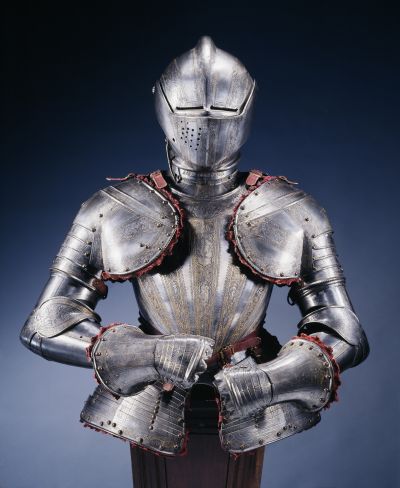Pompeo della Cesa è stato uno dei più abili armorari milanesi della seconda metà del XVI secolo. Lavorò per numerose corti italiane ed europee dell’epoca, tra le quali i Farnese del Ducato di Parma e Piacenza ed i Savoia, raggiungendo una considerevole fama e fortuna grazie alla realizzazione di armature e ‘guarniture’, ossia un insieme omogeneo di pezzi intercambiabili, che potevano così trasformare, sostituendo o aggiungendo pezzi supplementari, un’armatura ‘da piede’ in ‘armatura da cavallo’ o in ‘da giostra’. Il Museo di Arte di Cleveland annovera nella propria collezione uno spendido esempio di “Mezza armatura per i piedi”, realizzata intorno al 1590 dal della Cesa.
In addition to its magnificent cathedral, one of the great visitor attractions of the city of Milan is the large fortress known as the Castello Sforzesco or Sforza Castle, built in the 15th century by Francesco Sforza, Duke of Milan. Francesco started construction in 1450 on the remains of an earlier fortification in order to turn it into his princely residence. It remains an imposing example of Italian Renaissance military architecture. Within the Cleveland Museum of Art’s much beloved Armor Court is a “Half Armor for the Foot Tournament” made around 1590 by the celebrated Milanese armorer, Pompeo della Cesa. It provides an unexpected connection to Sforza Castle, where the armor workshops of Pompeo were located.
Pompeo della Cesa was a prolific and highly creative craftsman and certainly among the most renowned Italian armorers of the late 16th century. Milan, during the 15th and 16th centuries, was one of Europe’s major centers for the manufacturing of quality armor. The city’s celebrated armors were much sought after by princes and aristocrats across Europe. Armor from Milan was considered among the best, perhaps not unlike today’s Ferrari or Lamborghini automobiles. They were affordable only to an elite few and Pompeo’s “brand” was the Versaci of the 16th century. Archival documents date Pompeo’s activity in Milan to the years 1572-1593 and refer to his various titles, "Armorer to the Court of the Governor of Milan" (from 1585) and "Royal Armorer" (in 1592). Numbered among Pompeo's clientele were some of the most celebrated noblemen of their day. These included the two Spanish kings, Philip II and III, as well as Alessandro Farnese (1545-92), Duke of Parma and Piacenza; Vincenzo I Gonzaga (1562-1612), Duke of Mantua; and Emanuele Filiberto (1528-80), Duke of Savoy.
Many of the armors made for these luminaries survive today in numerous European and a few U.S. museums. The lack of archival evidence or an impresa on this particular suit unfortunately prevents us from firmly identifying its original owner, though he must have been someone of aristocratic status. Though a suit of armor continued to provide protection for the warrior on the battlefield or while competing in the tournament, it assumed another important role in Renaissance society. A beautifully crafted and decorated armor served the aggrandizement of the wearer by symbolizing his rank and authority. Armor reflected contemporary male fashion and aristocrats eagerly sought the most skilled armorers, a technically demanding craft, to provide them with the latest styles.
Custom made for a specific individual, the museum’s splendid etched and gilded half-armor may be identified on the strength of its form and decoration as the work of Pompeo della Cesa. The armor was surely made in Sforza Castle in Pompeo’s large workshop. It was designed specifically for use in an event known as the foot tournament. Tournaments were the great sporting events of the period. Costly and extravagant, they often featured days of jousting often combined with music, pageantry and feasting. The equestrian jousts popularized during the Middle Ages and still highly favored among Renaissance aristocracies throughout Europe, often included various forms of foot combat. Increasingly, these friendly combats on foot evolved their own rules of engagement as well as armor configuration. As the contestants commonly fought over a barrier which provided separation and gave protection to their legs, a half-armor, such as this one, provided sufficient protection. The original owner of this suit would have worn it with colorful puffed and slashed britches and hose. The use of colorful accessories such as a large ostrich feather plume (a brass plume holder may be seen on the back of the helmet) and red velvet pickadils between the steel plates would have provided for additional sartorial splendor.
Typically, armors made for patrons of this rank were of very high quality and ostentation was of paramount importance for public spectacles such as tournaments or pageants and parades. Most patrons of means afforded the additional expense of embellishing or decorating their armors. The most frequently used decorative technique, as seen on the museum’s armor, was etching in which acid was used to "bite" into exposed surfaces of the armor's steel plates to create permanent patterns. The etched and gilded decoration of this armor features vertical bands of strapwork enclosing cartouches which in turn contain allegorical figures, classical warriors and trophies. The decoration is deeply "bitten" into the steel and represents Pompeo's classic style of armor decoration, one which is found on over 40 surviving suits.
The form of the present armor, specifically its waistline, is a useful indicator of date. In general, armor form traditionally mimics contemporary male fashion. Waistlines of armors rose and fell according to the dictates of male clothing fashions. The deep peascod waist of the 1570s and early 1580s gave way to a lessening frontal curve through the mid-1590s, which became virtually a horizontal waistline by the first decade of the 17th century. The waistline of Cleveland’s Pompeo's armor stylistically dates to about 1590. In its day, Pompeo’s armor reflected the latest fashion and a much sought after brand; Italian style at its finest.



